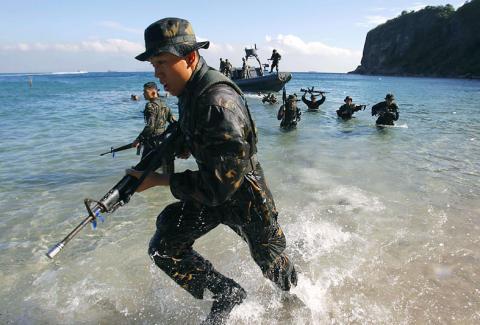A wrecked Philippine navy transport ship perched on a remote coral reef could be the next flashpoint in the South China Sea, where Taiwan, China and four other claimants bitterly dispute territory, officials say.
The Philippines is accusing China of encroachment after three Chinese ships, including a naval frigate, converged just 5 nautical miles (9 km) from an old transport ship that Manila ran aground on a reef in 1999 to mark its territory.
Philippine officials say they fear the Chinese ships will block supplies to about a dozen Filipino marines stationed in abject conditions on the rusting ship, raising tensions over one of Asia’s biggest security issues.

Photo: Reuters
The area, known as Second Thomas Shoal (Renai Shoal, 仁愛暗沙), is a strategic gateway to Reed Bank (Lile Bank, 禮樂灘), believed to be rich in oil and natural gas. In 2010, Manila awarded a consortium a licence to explore for gas on the Reed Bank, but drilling stalled last year due to the presence of Chinese ships.
The shoal is one of several possible flashpoints in the South China Sea that could force the US to intervene in defense of its Southeast Asian allies.
Manila says the Reed Bank, about 148km west of Palawan Island at the southwestern end of the Philippine archipelago, is within the country’s 200 nautical mile (370.4km) exclusive economic zone.
Beijing says it is part of the Spratly Islands (Nansha Islands, 南沙群島), a group of 250 uninhabitable islets, claimed entirely by Taiwan, China and Vietnam, and in part by Malaysia, Brunei and the Philippines.
“China should pull out of the area because under international law, they do not have the right to be there,” Philippine Department of Foreign Affairs spokesman Raul Hernandez said. He added that the Chinese ships were a “provocation and illegal presence.”
Chinese Foreign Ministry spokesman Hong Lei (洪磊) said on Tuesday that the Second Thomas Shoal was part of the Spratly Islands, over which China had “indisputable sovereignty.”
“It is beyond reproach for Chinese boats to carry out patrols in these waters,” Hong said, adding that China called on all parties to “refrain from taking actions that complicate the situation.”
A report issued on Tuesday by Chinese military think tank the Center for National Defense Policy said it was the US’ “pivot” back to Asia which had “shattered” the relative calm of the South China Sea, warning of a crisis ahead.

The combined effect of the monsoon, the outer rim of Typhoon Fengshen and a low-pressure system is expected to bring significant rainfall this week to various parts of the nation, the Central Weather Administration (CWA) said. The heaviest rain is expected to occur today and tomorrow, with torrential rain expected in Keelung’s north coast, Yilan and the mountainous regions of Taipei and New Taipei City, the CWA said. Rivers could rise rapidly, and residents should stay away from riverbanks and avoid going to the mountains or engaging in water activities, it said. Scattered showers are expected today in central and

People can preregister to receive their NT$10,000 (US$325) cash distributed from the central government on Nov. 5 after President William Lai (賴清德) yesterday signed the Special Budget for Strengthening Economic, Social and National Security Resilience, the Executive Yuan told a news conference last night. The special budget, passed by the Legislative Yuan on Friday last week with a cash handout budget of NT$236 billion, was officially submitted to the Executive Yuan and the Presidential Office yesterday afternoon. People can register through the official Web site at https://10000.gov.tw to have the funds deposited into their bank accounts, withdraw the funds at automated teller

COOPERATION: Taiwan is aligning closely with US strategic objectives on various matters, including China’s rare earths restrictions, the Ministry of Foreign Affairs said Taiwan could deal with China’s tightened export controls on rare earth metals by turning to “urban mining,” a researcher said yesterday. Rare earth metals, which are used in semiconductors and other electronic components, could be recovered from industrial or electronic waste to reduce reliance on imports, National Cheng Kung University Department of Resources Engineering professor Lee Cheng-han (李政翰) said. Despite their name, rare earth elements are not actually rare — their abundance in the Earth’s crust is relatively high, but they are dispersed, making extraction and refining energy-intensive and environmentally damaging, he said, adding that many countries have opted to

CONCESSION: A Shin Kong official said that the firm was ‘willing to contribute’ to the nation, as the move would enable Nvidia Crop to build its headquarters in Taiwan Shin Kong Life Insurance Co (新光人壽) yesterday said it would relinquish land-use rights, or known as surface rights, for two plots in Taipei’s Beitou District (北投), paving the way for Nvidia Corp to expand its office footprint in Taiwan. The insurer said it made the decision “in the interest of the nation’s greater good” and would not seek compensation from taxpayers for potential future losses, calling the move a gesture to resolve a months-long impasse among the insurer, the Taipei City Government and the US chip giant. “The decision was made on the condition that the Taipei City Government reimburses the related